I spotted this New Guinea Impatiens ( Impatiens hawkeri ) growing in a pot close to the street in an open carport. These plants grow to only around 40 cm tall, but what they lack in height is more than made up for by the flower display. The flowers are mostly abundant during the warmer months, and variety of colours available is amazing. if you live in a temperate to warm climate, you should find space for a few. Try to plant them in a spot that avoids the hot afternoon sun, as they are happiest in a spot with morning sun or part-shade and water regularly.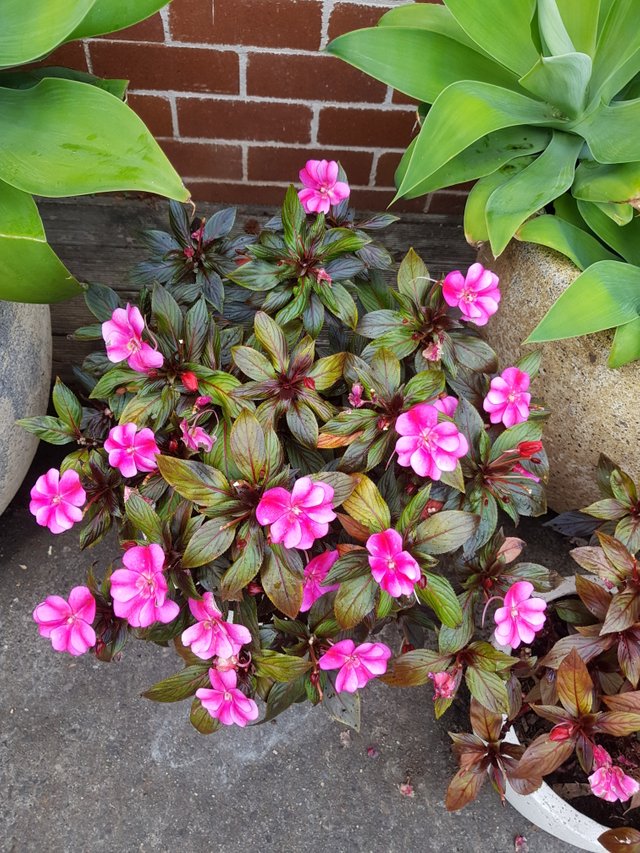
Authors get paid when people like you upvote their post.
If you enjoyed what you read here, create your account today and start earning FREE STEEM!
If you enjoyed what you read here, create your account today and start earning FREE STEEM!
Few flowers are as popular as impatiens, (Impatiens walleriana). They are one of the few flowers that bloom continuously and thrive in shade, with little care. If you've ever wished you could find a similar long bloomer for a sunny spot in the garden, take a look at their cousins, the New Guinea impatiens, Impatiens hawkeri.
New Guinea impatiens form small clumps and hold their many flowers above their foliage, where they make a colorful display. No deadheading is required to keep them repeat blooming for months. With few pests or problems, New Guinea impatiens offer low maintenance and high performance.
Expect your New Guinea impatiens to start blooming early in the season, if they aren't already in bloom when you buy them. They will bloom continuously if they are getting enough sun and water.
New Guinea impatiens like a slightly acidic soil pH in the range of 6.0 - 6.5, but they are not terribly particular about it. They will need a well-draining soil, that holds moisture long enough for the roots to soak it up. New Guinea impatiens are not drought tolerant, but you don't want them sitting in wet soil for long periods or their crowns could rot.
Source
Downvoting a post can decrease pending rewards and make it less visible. Common reasons:
Submit
Silly Sausage Award !! Well done, you chose great Pics and information.
Downvoting a post can decrease pending rewards and make it less visible. Common reasons:
Submit
New Guinea impatiens are a tropical plant hailing from—you guessed it—New Guinea. These plants have succulent stems and attractive foliage that both create a wonderful backdrop for their large blooms. There are also many foliage variations of New Guineas.
Flowers of New Guinea impatiens are like a maximized version of standard impatiens flowers. Pink, white, lavender, and orange create wonderful palettes to incorporate into your garden. All flowers are composed of five thick petals. Impatiens also have a flower spur full of nectar, which makes them a favorite of moths and butterflies.
Plant New Guinea impatiens in nutrient-rich, well-drained soil. New Guineas aren't vigorous, so they won't take up a lot of space in a garden bed. They make great accents and create pops of color when mixed with filling shade plants.
Fortunately, New Guinea impatiens are resistant to downy mildew, which can quickly wipe out other impatiens varieties. Typical garden pests like aphids, thrips, and spider mites are common problems that New Guineas can run into.
https://www.bhg.com/gardening/plant-dictionary/annual/new-guinea-impatiens/
Downvoting a post can decrease pending rewards and make it less visible. Common reasons:
Submit
Fav. comment Award !! Great Pics, thanks.
Downvoting a post can decrease pending rewards and make it less visible. Common reasons:
Submit
Brighten shady corners of your landscape with something besides traditional impatiens: Try New Guinea impatiens. This impatiens cousin opens beautiful, large flowers on plants with eye-catching foliage in shades of green, burgundy tints and variegated forms. New Guinea impatiens (Impatiens hawkeri) is an easy-growing annual that isn’t demanding in terms of care.
Compared to traditional shade-loving impatiens, New Guinea impatiens offers several positive differences. First, the flowers are larger. You’ll find a similar wide variety of blossom shades in both types of impatiens; neither offers a strong sky blue. Yellow has been an elusive flower color in impatiens, but New Guinea impatiens brings that in the variety Vision Yellow. New Guinea impatiens flowers open in a host of dazzling hues, including orange, red, pink, white, purple and lavender.
https://www.hgtv.com/outdoors/flowers-and-plants/new-guinea-impatiens
Downvoting a post can decrease pending rewards and make it less visible. Common reasons:
Submit
Impatiens hawkeri is native to Papua New Guinea and the Solomon Islands. They have been popular as a greenhouse plant since the 19th century, but they have been improved by much hybridisation in recent years.
They have the same rich, jewel-like flower colours of the ordinary 'busy Lizzy' (Impatiens walleriana) and also bloom very well in shade. However, the flowers are larger and more showy, and the plants are more sun-tolerant than their cousins, which wilt dramatically if exposed to direct sunlight.
Morning sun seems to be best for the New Guinea varieties; too much sun can apparently be detrimental - though some are marketed as being quite sun-hardy, as long as they are kept well watered.
They are not afflicted by the 'impatiens downy mildew' that has wiped out busy Lizzies all around the world. There is currently no cure for this disease.
The plants have a neat, mounded shape, to a height of 20 to 30 cm. They are perfect for containers - in a big pot, three plants will grow together to form an impressive mass. They are self-cleaning - so no dead-heading is required.
Source
Downvoting a post can decrease pending rewards and make it less visible. Common reasons:
Submit
Wonderful Pics !!
Downvoting a post can decrease pending rewards and make it less visible. Common reasons:
Submit
Traditional New Guinea impatiens are easily grown in evenly moist, organically rich, well-drained soils in part shade. Morning sun with afternoon shade is best. Tolerates full shade.
Needs protection from full sun, particularly in climates with hot and humid summers. Plants perform well in raised beds where soil is well aerated. Pinch back stems of young plants to encourage branching and/or compact growth. Sheer plants in mid-summer that become leggy.
Plants are winter hardy to USDA Zones 10-12. Unless a particularly special or unique plant is involved, most gardeners north of Zone 10 simply purchase cell packs in spring, enjoy the long flowering season, allow the plants to succumb to frost in fall, and then purchase new plants the following spring.
If a prized impatiens is to be overwintered indoors, it should be sheared back, brought indoors before temperatures dip into the 40 degree F range, placed in a full sun area (sunny windowsill is similar in light intensity to sun-dappled shade outdoors), and regularly watered.
sOURCE
Downvoting a post can decrease pending rewards and make it less visible. Common reasons:
Submit
I am a big fan of this plant for one primary reason. It is an annual that does well in a shaded environment.
An abundant selection of colors to create a beautiful display in your yard and low maintenance needs! New Guinea Impatiens are perfect when your yard has just too much sun for “regular” Impatiens. The rainbow sized selection of colors makes using them not only fun, but easy.
Source
Simply find your favorite color, plant in your favorite spot and VIOLA you have created art! Care for this plant like you would anything else, water regularly during the hottest months…and honestly that’s about it. You will love looking out your window at the color bonanza happening around your home.
Source
Provide your New Guinea Impatiens with either shade or part sun, morning sunshine and afternoon shade would be perfect. You will want to plant this in a spot that has moist soil, or remember to water it regularly.
Compact SunPatiens have flower power and are low maintenance and reliable. They work well in window boxes, patio containers, baskets and landscape beds, and last from spring until first killing frost. They are everything we want in a flowering bedding plant for summer color.
Source
Source
Source
Text Source
Downvoting a post can decrease pending rewards and make it less visible. Common reasons:
Submit
New Guinea impatiens (Impatiens hawkeri) produce much larger flowers than other impatiens. Prized by home gardeners for the colors of these blooms, which almost glow with vibrancy, New Guinea impatiens are named after their native island of New Guinea. Although their initial introduction to the United States in 1970 didn’t go well, plant breeders have since created new cultivars that have made New Guinea impatiens a common potted and landscape plant in American gardens. The plant grows in U.S. Department of Agriculture plant hardiness zones 10 through 12 and as annuals everywhere.
Place your plant in a location that receives morning sun and afternoon shade. While New Guinea impatiens love sunlight for part of the day, they won’t bloom as well if they receive too much. They require about four to six hours of afternoon shade. Eastern exposures are often ideal.
https://homeguides.sfgate.com/care-new-guinea-impatiens-43324.html
Downvoting a post can decrease pending rewards and make it less visible. Common reasons:
Submit
Impatiens is a slow-growing plant, and you’ll need to start the seedlings about three months before your last spring frost. Impatiens seed germination can take up to 21 days, with most of the sprouting happening within the first two weeks.
Some gardeners may try to save money by broadcasting the seeds over a tray, then transplanting the tiny seedlings once they grow leaves, but you’ll reduce the chance of transplant shock if you start the seeds off in individual small pots or six-pack cells of their own.
You’ll have to transplant the seedlings to there anyway, so you might as well start them in their eventual home. Any empty cells from seeds that don’t sprout are a small price to pay for healthier, sturdy impatiens.
Growing impatiens from seeds is a slow process, but a simple one. Fill each cell with a moistened commercial seed-starting mix, leaving ½ inch space between the top of the soil and the edge of the planter. Put the cells on a tray and fill the tray with water. Allow the mix to soak up water from the bottom until the top of the mix is moist. Pour the rest of the water out of the tray.
Source
Downvoting a post can decrease pending rewards and make it less visible. Common reasons:
Submit
Few flowers are as popular as impatiens. They are one of the few flowers that bloom continuously and thrive in shade, with little care. If you've ever wished you could find a similar long bloomer for a sunny spot in the garden, take a look at their cousins, the New Guinea impatiens, Impatiens hawkeri.
photo source
photo source
New Guinea impatiens form small clumps and hold their many flowers above their foliage, where they make a colorful display. No deadheading is required to keep them repeat blooming for months. With few pests or problems, New Guinea impatiens offer low maintenance and high performance.
image source
Leaves: Glossy, dark green, burgundy, or variegated, pointed, oblong leaves. The leaves stay attractive throughout the season.
Flowers: The flowers are similar, but larger than the flowers of common impatiens and they come in just about every color but true blue. New varieties are introduced yearly.
Botanical Name
Impatiens hawkeri
article source
Downvoting a post can decrease pending rewards and make it less visible. Common reasons:
Submit
New Guinea impatiens form small clumps and hold their many flowers above their foliage, where they make a colorful display. No deadheading is required to keep them repeat blooming for months. With few pests or problems, New Guinea impatiens offer low maintenance and high performance.
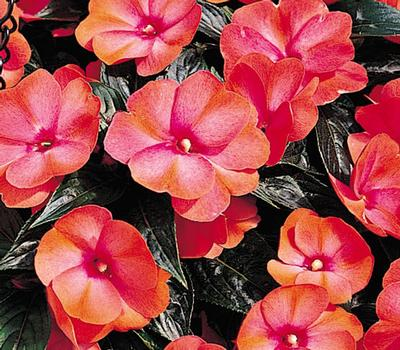
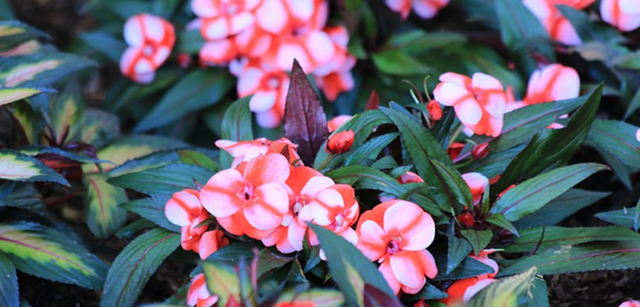
New Guinea impatiens form small clumps and hold their many flowers above their foliage, where they make a colorful display. No deadheading is required to keep them repeat blooming for months. With few pests or problems, New Guinea impatiens offer low maintenance and high performance.
Plant New Guinea impatiens in a shady location with rich, well-drained soil. Use a commercial potting mix if you are growing New Guinea impatiens in containers. Keep the soil slightly moist at all times. New Guinea impatiens don't like sitting in water, but they wilt dramatically if allowed to dry out.
References123
Downvoting a post can decrease pending rewards and make it less visible. Common reasons:
Submit
New Guinea impatiens (Impatiens Hawkeri) also known as Hawker, is a perennial plant. Impatiens are also known as busy Lizzie. The plant has shiny glossy foliage. They own one of the most colorful flowers in the world. They belong to the family of Balsamin.
It is a medium maintenance plant. You can use it as an ornamental plant from your garden to your indoor hanging baskets. If you are planting it indoors then use a big pot to provide better circulation and gradually it will be easier to provide a considerable amount of water.
Water the impatiens regularly. They require a medium amount of water. They are the best plant to grow beside another plant. It is xeriscape in nature. And over the top, you would get a lush full of vibrant colors. Do not exceed the water levels. 2 to 4 cups of water would be good enough.
Also, make sure you do not let the soil to dry out between the watering. They have this ability to recover back from wilting within a few hours after watering. Impatiens provides fragrance and color in your garden. It is said that the impatiens can help you to empower your emotional state.
Source
Downvoting a post can decrease pending rewards and make it less visible. Common reasons:
Submit
Impatiens hawkeri, commonly known as New Guinea Impatiens, is a species within the vast genus of Impatiens which in turn belongs to the balsalminaceae family. It is native to the Melanesian island of New Guinea and has only very recently been introduced to the nursery industry after being discovered on a plant expedition in the 1970s.
Through modern breeding techniques, the gangly and poor flowering specimens have been transformed into one of the most popular bedding plants, with extra large flowers and excellent compact branching habits.
Impatiens form compact, succulent sub-shrubs. By summer’s end, they can reach a height of up to 60cm, variety dependent. The leaves are ovate in shape and slightly elongated. The edges are finely serrated and the colours of the leaves are as varied and striking as the flowers. They can either be plain or variegated and the colours include various shades of green, purple, lemon, peach and bronze.
The flowers of the New Guinea are simple in construction, but their size and bold, bright colour is what makes them so striking. The colour palette includes various pinks, purples, lavenders, reds as well as orange and white. Whilst most of the flowers are solid in colour, you will find bicolours in some varieties.
Source
Downvoting a post can decrease pending rewards and make it less visible. Common reasons:
Submit
Impatiens hawkeri, commonly called New Guinea impatiens, is a very popular bedding plant in the U.S. today. It is a broadly defined species that is native to New Guinea, the Solomon Islands and New Ireland.
It was first collected by Lt. Hawker (hence the specific epithet) in Papua, New Guinea in 1884, but was not introduced into the U.S. until the early 1970s. New Guinea impatiens for the most part features larger plants, larger flowers and better performance in part shade areas than the popular standard impatiens (Impatiens walleriana).
They are commonly grown in part shade to shade areas, with little tolerance for full sun. Leaves are in whorls of 3 to 7 leaflets. Oval to elliptic leaflets (2-4" long) are dark green to bronze to variegated. Flattened 5-petaled flowers come in a variety of colors including white, pink, orange, red, violet, and purple.
Plants typically grow to 6-18" tall. Flowering is non-stop from May to October. New Guinea impatiens have now been developed into a huge number of different cultivars some of which have been introduced as part of named series.
Source
Downvoting a post can decrease pending rewards and make it less visible. Common reasons:
Submit
Impatiens hawkeri, the New Guinea impatiens, is a species of flowering plant in the family Balsaminaceae. It is native to Papua New Guinea and the Solomon Islands. It has been bred and hybridized in cultivation to produce a line of garden plants.
Source
The plants have a neat, mounded shape, to a height of 20 to 30 cm. They are perfect for containers - in a big pot, three plants will grow together to form an impressive mass. They are self-cleaning - so no dead-heading is required.
Source
If they are grown in a pot set on paving, wooden decking or tiles, it is advisable to sweep away fallen flowers regularly, as these can adhere annoyingly to the surface after a while.
Source
Colors range from bright hot colors of reds and oranges, to cooler hues of white, pinks, cerise and purples. Some of them have interesting foliage as well.
Source
Note that when growing plants in outdoor containers and baskets, they may require more frequent watering than they would in the yard or garden.
Information Source: 1, 2, 3
Downvoting a post can decrease pending rewards and make it less visible. Common reasons:
Submit
New Guinea impatiens (Impatiens hawkeri) is a fairly new type of impatiens that offers quite a few benefits over the traditional Elfin (Impatiens walleriana ) variety. This good looking breed sports oversized, showy flowers and variegated leaves.
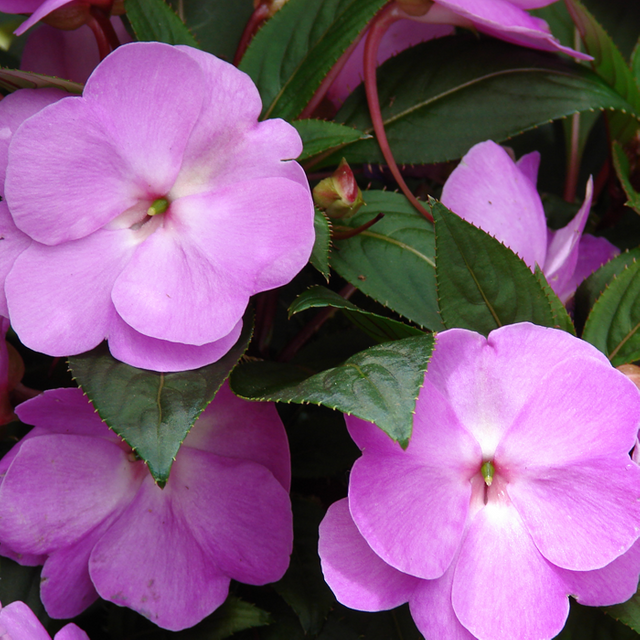.png)
source of photos
It is able to thrive in many parts of the garden because it tolerates and even prefers partial sun. It is also a vigorous grower that gains more size than the old-fashioned variety and is able to fill in more space with fewer plants.
source
Downvoting a post can decrease pending rewards and make it less visible. Common reasons:
Submit
New Guinea impatiens (Impatiens hawkeri) grow up to 2 feet in height and produce flowers in a myriad of colors including pink, white, orange, purple and red.
The ornamental foliage can be green, bronze or burgundy in color. Hardy in U.S. Department of Agriculture plant hardiness zones 10 through 12,
New Guinea impatiens are commonly grown as annuals throughout the United States. Their colorful blooms grace gardens from spring through fall.
source
Downvoting a post can decrease pending rewards and make it less visible. Common reasons:
Submit
New Guinea impatiens (Impatiens hawkeri) produce much larger flowers than other impatiens. Prized by home gardeners for the colors of these blooms, which almost glow with vibrancy, New Guinea impatiens are named after their native island of New Guinea.
Although their initial introduction to the United States in 1970 didn’t go well, plant breeders have since created new cultivars that have made New Guinea impatiens a common potted and landscape plant in American gardens. The plant grows in U.S. Department of Agriculture plant hardiness zones 10 through 12 and as annuals everywhere.
Place your plant in a location that receives morning sun and afternoon shade. While New Guinea impatiens love sunlight for part of the day, they won’t bloom as well if they receive too much. They require about four to six hours of afternoon shade. Eastern exposures are often ideal.
Water indoor plants when the soil begins to dry. New Guinea impatiens prefer consistently moist soil. However, they cannot tolerate soil that is soggy or too dry. If the soil dries out completely between watering, your plant may wilt or lose flowers. A thorough drench once each week is usually enough for plants grown outdoors. Indoor plants may require more frequent watering.
Source
Downvoting a post can decrease pending rewards and make it less visible. Common reasons:
Submit
Colour your summer with this versatile Impatiens; in the garden or indoors
The New Guinea impatiens are a great value bedding plant, they flower all summer into autumn and they make quite a large plant so you don’t need as many to have a good show.
They have become a lot more popular in the last few years as they don’t get the highly contagious downy mildew that has plagued Busy Lizzies. Unfortunately Busy Lizzies are one of the few summer bedding plants that will thrive and give you some colour in a shady spot.
The New Guineas won’t thrive in the shade but do need to be out of the midday sun. The flowers are much larger than Busy Lizzies and come in shades of orange, red and lavender, and also pure white. As their name suggests they are a tropical plant native to Papua New Guinea and the Solomon Islands.
Position
Pick a spot out of the midday sun but where they receive morning and late afternoon sun. If planting in the garden you need good moisture retentive, but not soggy, fertile soil. If you are growing it as a houseplant don’t place it in a south facing window, it will last a lot longer if shaded from the midday sun and kept on the cool side.
Planting
If planting in containers use good quality peat-free compost with slow release fertiliser and water retention gel added. When planting in the garden add some balanced fertiliser such as Growmore or blood, fish and bone. They make a thick mound about 30cm (12”) in diameter so don’t plant them too close together.
source
Downvoting a post can decrease pending rewards and make it less visible. Common reasons:
Submit
@ctrl-alt-nwo,
That flower has shaded colors! I like it and it's truly stunning and good to have at garden! Moreover the leaves also looks beautiful! Didn't see this flower in my country so far! Probably it can make high demand in my country also! Nice photography and a useful article!
Cheers~
Downvoting a post can decrease pending rewards and make it less visible. Common reasons:
Submit
Surprisingly, we call this flower "Vanka wet," in the childhood we grew up in our house. Balzamin - a flower with many names.
Downvoting a post can decrease pending rewards and make it less visible. Common reasons:
Submit
The flowers are colorful and very easy to grow on soil that contains a lot of humus. It is suitable to be planted to decorate the edge of the pond, or on the ground near water.
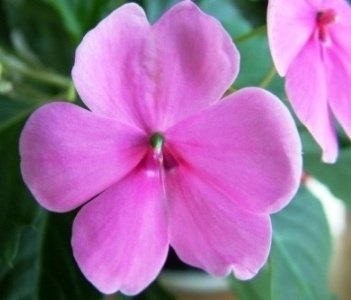
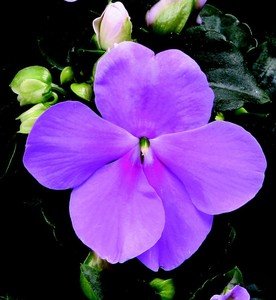

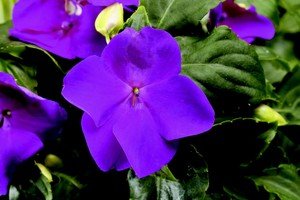
Planting is very easy, we only need to take the old seeds (children usually like to pick the fruit of this plant, because if the old fruit is touched a little, it explodes, the seeds come out and the fruit skins roll quickly. One of the mechanisms of natural seed distribution is very good, seeds are planted directly on the ground, in a few days we will be able to see a lot of tillers growing.
We can immediately move the tillers who already have 4-5 leaves safely to the place we want that has been given humus. Make sure the plant gets enough water, but don't stagnate to avoid decaying the stem.
Some types of Impatiens can also be planted by separating stems that have little aerial roots (sometimes we can find air roots at the base of the branches of this plant. I have tried several times and succeeded.
This plant is fast flowering. In a matter of less than a month sometimes it can flower. The flowers are very beautiful and alive. Colorful, ranging from red, orange, red, purple, pink, pale orange, pale pink and even a few years ago I had the opportunity to have white ones. The bright colors of the henna water flowers invite many butterflies to come, so for fans of butterflies, planting these plants is very profitable.
Source:
https://www.google.co.id/url?sa=t&source=web&rct=j&url=https://nimadesriandani.wordpress.com/2011/01/13/impatiens%25E2%2580%25A6-si-kembang-pacar-air/amp/&ved=2ahUKEwjXwuWN5r_dAhVIWH0KHWswCt8QFjAZegQIBBAB&usg=AOvVaw2GXAhYeugHB8H71dWj52Bs&cf=1
Downvoting a post can decrease pending rewards and make it less visible. Common reasons:
Submit
Shared on twitter promoting good quality content on #Steemit. Stephen
#Promo-Steem #steemtalent #JoinSteemit #Steemit
New Guinea Impatiens. #STEEM #steemtalent #JoinSteemit #Steemit @Steemit
#plants #garden #gardening #photographer #photography #australia
https://twitter.com/StephenPKendal/status/1041343258847313922
Downvoting a post can decrease pending rewards and make it less visible. Common reasons:
Submit
Wow! This plant is very impressive with lots of flowers and explosive colours!
The flood has gone and the land is getting dry. I two weeks’ time, we should be able to clear all the dead plants and trees. I’ll have start making plan about new saplings and plants!
Cheers.
Downvoting a post can decrease pending rewards and make it less visible. Common reasons:
Submit
I hear that Indonesia is having a bad drought and you got too much rain.
Downvoting a post can decrease pending rewards and make it less visible. Common reasons:
Submit
That’s life! It’s difficult to find a harmonious balance as we wish. I think Mother Earth is quite ill from all the pollution. And that’s probably her symptoms!
Hope for things to get healed faster.
Downvoting a post can decrease pending rewards and make it less visible. Common reasons:
Submit
Very very beautiful photo. The combination of colors is unique. I was very surprised by the combination of colors, it is excellent.
Downvoting a post can decrease pending rewards and make it less visible. Common reasons:
Submit
New Guinea impatiens are a tropical plant hailing from—you guessed it—New Guinea.

These plants have succulent stems and attractive foliage that both create a wonderful backdrop for their large blooms. There are also many foliage variations of New Guineas.
Flowers of New Guinea impatiens are like a maximized version of standard impatiens flowers. Pink, white, lavender, and orange create wonderful palettes to incorporate into your garden.
All flowers are composed of five thick petals. Impatiens also have a flower spur full of nectar, which makes them a favorite of moths and butterflies.
Source
Downvoting a post can decrease pending rewards and make it less visible. Common reasons:
Submit
Pink and white color flower combination makes this plant awesome . And in comment section many other colors variety of this plant . Good plant .
Downvoting a post can decrease pending rewards and make it less visible. Common reasons:
Submit
Really New Guinea Impatiens is a beautiful plants. Pleased to know about this plants. These ornamental plants come from Papua New Guinea (New Guinea). Therefore this plant is called New Guinea Impatiens. Thats really interesting.
image source
image source
This flowering plant is more suitable for planting in pots because of its small and short shape. So we can make a beautiful garden with this plants.
image source
I eagerly waiting for your next article as you always share new plants and flowers.
Downvoting a post can decrease pending rewards and make it less visible. Common reasons:
Submit
Nice spotting there looks so cool and epic very unique one
Downvoting a post can decrease pending rewards and make it less visible. Common reasons:
Submit
Impatiens hawkeri, commonly known as New Guinea Impatiens, is a species within the vast genus of Impatiens which in turn belongs to the balsalminaceae family.
It is native to the Melanesian island of New Guinea and has only very recently been introduced to the nursery industry after being discovered on a plant expedition in the 1970s.
Through modern breeding techniques, the gangly and poor flowering specimens have been transformed into one of the most popular bedding plants, with extra large flowers and excellent compact branching habits.
SunpatiensOrangeNew Guinea Impatiens form compact, succulent sub-shrubs. By summer’s end, they can reach a height of up to 60cm, variety dependent. The leaves are ovate in shape and slightly elongated. The edges are finely serrated and the colours of the leaves are as varied and striking as the flowers.
They can either be plain or variegated and the colours include various shades of green, purple, lemon, peach and bronze.
The flowers of the New Guinea are simple in construction, but their size and bold, bright colour is what makes them so striking. The colour palette includes various pinks, purples, lavenders, reds as well as orange and white. Whilst most of the flowers are solid in colour, you will find bicolours in some varieties.
source
Downvoting a post can decrease pending rewards and make it less visible. Common reasons:
Submit
Bountiful Blooms
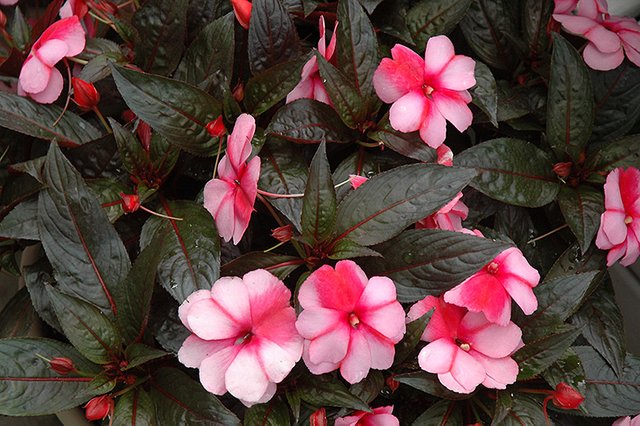
New Guinea impatiens are a tropical plant hailing from—you guessed it—New Guinea. These plants have succulent stems and attractive foliage that both create a wonderful backdrop for their large blooms. There are also many foliage variations of New Guineas.
Flowers of New Guinea impatiens are like a maximized version of standard impatiens flowers. Pink, white, lavender, and orange create wonderful palettes to incorporate into your garden.
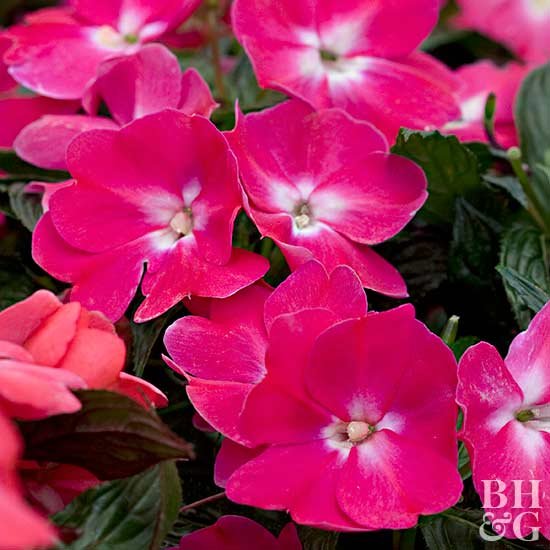
New Guinea Impatiens Care Must-Knows
New Guinea impatiens are happiest in part shade with consistently moist soil. If they start to wilt, give them a thorough watering and they should be back to normal in a few hours.
Source
Downvoting a post can decrease pending rewards and make it less visible. Common reasons:
Submit
Few flowers are as popular as impatiens, (Impatiens walleriana). They are one of the few flowers that bloom continuously and thrive in shade, with little care.
If you've ever wished you could find a similar long bloomer for a sunny spot in the garden, take a look at their cousins, the New Guinea impatiens, Impatiens hawkeri.
New Guinea impatiens form small clumps and hold their many flowers above their foliage, where they make a colorful display. No deadheading is required to keep them repeat blooming for months. With few pests or problems, New Guinea impatiens offer low maintenance and high performance.
Leaves: Glossy, dark green, burgundy, or variegated, pointed, oblong leaves. The leaves stay attractive throughout the season.
Flowers: The flowers are similar, but larger than the flowers of common impatiens and they come in just about every color but true blue. New varieties are introduced yearly.
Botanical Name
Impatiens hawkeri
Common Name
New Guinea Impatiens
Hardiness Zones
New Guinea impatiens are tropical plants that are only hardy in USDA Zones 10 – 11. Most gardeners grow them as an annual plant.
source
Downvoting a post can decrease pending rewards and make it less visible. Common reasons:
Submit
This beautiful flowers are just like me. I also love the morning sun, but at noon or afternoon I am more happy to be in the shadow :-)
Downvoting a post can decrease pending rewards and make it less visible. Common reasons:
Submit
@ctrl-alt-nwo, In my opinion, for sure this is beautiful combination and it holds the healing essence for sure.
And if we hold these kind of plants around us then for sure it will going to give an great essence for sure.
And just see those beautiful and artistic flowers which holds the breathtaking combination of pink and white.
And for me, flowers always reflects as nature's smile and whenever we got to see some amazing flowers it throws welcoming essence.
Wishing you an great day and stay blessed. 🙂
Downvoting a post can decrease pending rewards and make it less visible. Common reasons:
Submit
Gardeners have long loved impatiens for their ability to provide colorful flowers in shady places. In the 1970s, New Guinea Impatiens (Impatiens hawkeri) were introduced to U.S. gardeners.
while early varieties weren’t initially beloved, this plant has become a staple in many gardens now. They’re usually grown as annuals, planted in the spring in northern areas and year-round in frost-free zones.
Their colors include reds, pinks, oranges, and white. The foliage of New Guinea Impatiens is dark green and nearly purple on the undersides, making it attractive on its own.
They blooms constantly and require little maintenance. Here’s what you need to know to grow them.
source
Downvoting a post can decrease pending rewards and make it less visible. Common reasons:
Submit
Beautiful flowering plant there @ctrl-alt-nwo
It reminds me of some orchid flowers because of the contrasting colors of the flowers, the leaves are shiny a bot too.
Downvoting a post can decrease pending rewards and make it less visible. Common reasons:
Submit
These ornamental plants come from Papua New Guinea (New Guinea). Therefore this plant is called New Guinea Impatiens.
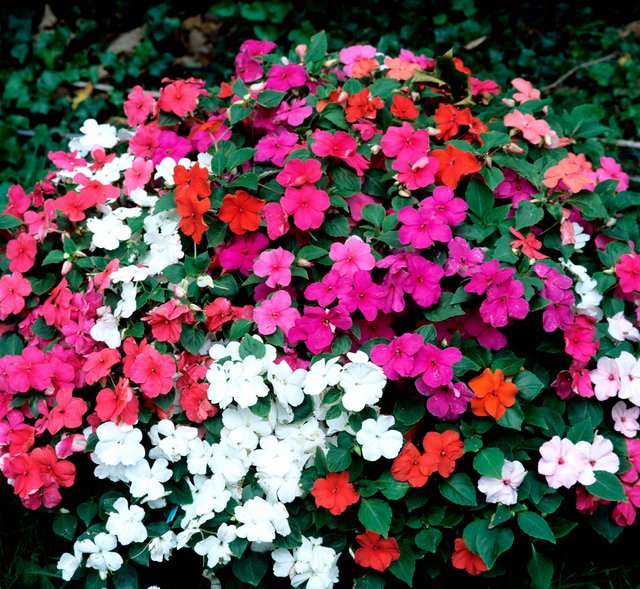
This plant will continue to bloom throughout the year if it is well cared for. France is a plant that does not grow tall or low plants. Liked the sun but if it is exposed to the sun continuously the flowers don't bloom too much. So it's better to plant this flower on the yard that gets the morning sun to maximize the flower blooms.
This flowering plant is more suitable for planting in pots because of its small and short shape. However, it can also be planted directly on the ground to cover the yard of the house where the land is empty. Uniquely this ornamental plant can also be stored in a shady place, only the effect is rarely flowering. However, if you decide to keep it in the shade, every 2 times a week you have to be dried in the sun so you can photosynthesize.
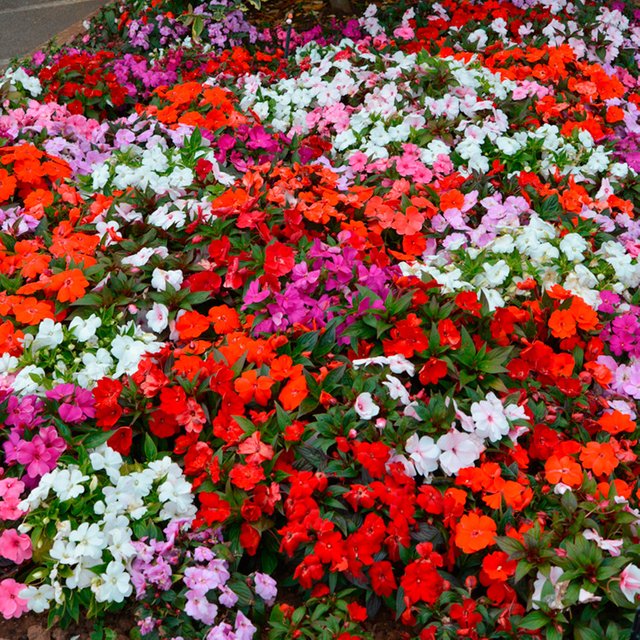
Plant by laying roots at the same depth of soil as in the original pot. For more satisfying results, use high quality soil pots. However, for starters it can be planted in the medium of raw husk, fuel husk or cocopeat. Do not use soil that has leather or wood chips. Flush when the soil begins to dry out, France likes soil that is moist and consistently, unable to tolerate soil that is too wet and dry. To plant indoor flush once a week is enough.
Loosen the soil in pots and add 30 to 50 percent of compost or peat to the soil to create adequate drainage. Store it in a place that receives morning sun and shade in the afternoon, ideally receiving an afternoon shade of around 4-6 hours. Unlike when planted indoors, outdoor planting requires regular watering every day. Avoid watering from the top of the plant and reduce flush if the media conditions are still too moist or cold.

Always add fertilizer that dissolves in water every one or two weeks, what should be remembered is that when the planting medium is dry, do not immediately apply fertilizer, but wet it first by ordinary water to avoid burning the roots. Pick every flower that is old and always clean the media from plant or weed flakes if any.
Actually not picked is also okay because the flowers that are too old will fall off on their own, but this is not neat. Conversely by picking old flowers can make the appearance of flowers and media always neat can also prevent fungal infections and diseases.
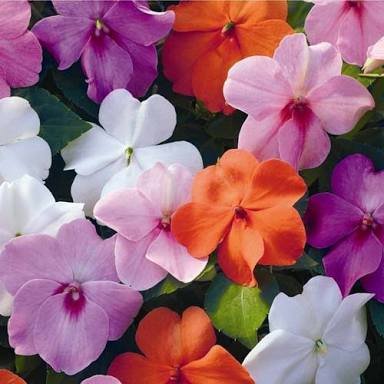.jpeg)
You are free to cut it according to the shape you want when France has grown irregularly lush, but it is recommended that after cutting, give water and fertilizer so that the plant can grow quickly recover. Basically, if the plant experiences wilting, it will recover soon after being given enough water, but if it is constantly left wilted even though it will recover when given water, this can result in a decrease in the quality of leaves and flowers.
Sources:
https://www.google.co.id/url?sa=t&source=web&rct=j&url=https://bunga-mawar.com/2017/07/jual-tanaman-hias-iriancis-new-guinea-impatiens.html&ved=2ahUKEwi-5emF7L_dAhUM4o8KHXWlDMoQFjAKegQIABAB&usg=AOvVaw1UREb5sky7NtiKATIbynJG
Downvoting a post can decrease pending rewards and make it less visible. Common reasons:
Submit
Nice Pics, but these are Impatiens wallerana, which are slightly different from New Guinea Impatiens (Impatiens hawkeri )
Downvoting a post can decrease pending rewards and make it less visible. Common reasons:
Submit
Growers can increase their success with one of the most popular segments of today’s bedding plant market through this detailed guide. A complete information source for New Guinea impatiens, this book includes information on plant culture, pest and disease management, postproduction care, and garden care.
https://books.google.lk/books/about/New_Guinea_Impatiens.html?id=lPpHAAAAYAAJ&redir_esc=y
Downvoting a post can decrease pending rewards and make it less visible. Common reasons:
Submit
The two tone made them very attractive.
Downvoting a post can decrease pending rewards and make it less visible. Common reasons:
Submit
Well yeah they may be small but they are indeed beautiful and their color and all of them look really amazing and lovely .
Nice of you to notice that by the way.
Nicely taken shot buddy
Downvoting a post can decrease pending rewards and make it less visible. Common reasons:
Submit
Surprisingly, we call this flower "Vanka wet," in the childhood we grew up in our house. Balzamin - a flower with many names
To date, a large number of varieties and hybrids, differing in plant height, color, size, degree of terry of the flower, have appeared variegated varieties. Many species are grown solely because of the beautiful, unusual shape of the flowers (pink, camellia, carnivorous). In addition, there are bouquet-bush, low branching forms up to 40 cm in height. The dwarf form is up to 25 cm high.
http://www.florets.ru/komnatnye-rasteniya/baljzamin/
Downvoting a post can decrease pending rewards and make it less visible. Common reasons:
Submit
Few flowers are as popular as impatiens, (Impatiens walleriana). They are one of the few flowers that bloom continuously and thrive in the shade, with little care. If you ever wanted to find a sunny patch in the garden, you can find a similar long slice, take a look at your cousin, New Guinea, Impatiens hawkeri. Since the new Guinean impatins are hybrids, most varieties can not be grown from seeds. They are either sterile or will not grow. However, there are some of them that have stabilized and the seeds are available if you want to give them a try. Fortunately, plants are easily accessible, and there is much more variety if you buy them as seedlings. You can also bring them for the winter, like houseplants, and they are easy to grow from cuttings.
https://ru.nctodo.com/how-to-grow-and-care-for-new-guinea-impatiens
Downvoting a post can decrease pending rewards and make it less visible. Common reasons:
Submit
Impatiens, New Guinea Plant Features
The gem-like flowers and foliage of New Guinea impatiens will transform shady spots in your landscape into a festival of color. These super-easy annual flowers can be used as eye-popping bedding plants or in container combinations.
New Guinea impatiens grow 12 to 15 inches tall and besides their colorful flowers, many New Guinea impatiens also offer variegated foliage. Hummingbirds will also visit the flowers for a quick snack.
Impatiens, New Guinea Growing Instructions
Plant New Guinea impatiens in a shady location with rich, well-drained soil. Use a commercial potting mix if you are growing New Guinea impatiens in containers.
Keep the soil slightly moist at all times. New Guinea impatiens don't like sitting in water, but they wilt dramatically if allowed to dry out.
New Guinea impatiens are not intended for human or animal consumption
source
Downvoting a post can decrease pending rewards and make it less visible. Common reasons:
Submit
When looking for an annual plant which will bloom throughout the summer months, the general opinion is you should look for Impatiens. An absolute favorite for both the fanatic and the amateur gardener, Impatiens are sold by the millions throughout the country and perhaps worldwide.
They can be readily found as seeds and transplants, in hanging baskets and as bedding plants. Because these plants are so easy to grow, are so readily available, so cheap to get, come in virtually every shade of the rainbow (minus a couple of colors, that is), make the garden sparkle like none other and are ever-blooming, they will never be surpassed in the annual bedding plant department.
There perhaps still is some confusion between Impatiens and New Guinea Impatiens. That would be the New Guinea Impatiens are as easy going plant as its cousin the regular or Impatiens wallerana to give it the correct botanical name.
Here is a crash course on the subtle and perhaps not-so-subtle variances between the New Guinea and the regular Impatiens.
source
Downvoting a post can decrease pending rewards and make it less visible. Common reasons:
Submit
Beautiful flowers and plant in general. Poisonous beauty))) Like a snake. It is made of alcohol tincture, which helps to fight with stones in the kidneys and bladder. Tell me please, this view of the Balzaminovs, shoots loudly, when the seed is smacked?
Downvoting a post can decrease pending rewards and make it less visible. Common reasons:
Submit
It was first collected in the Territory of Papua in 1884 and soon became popular as a greenhouse plant. After its discovery, fifteen other similar New Guinea taxa were collected, all of which were later determined to be forms of I. hawkeri.[2]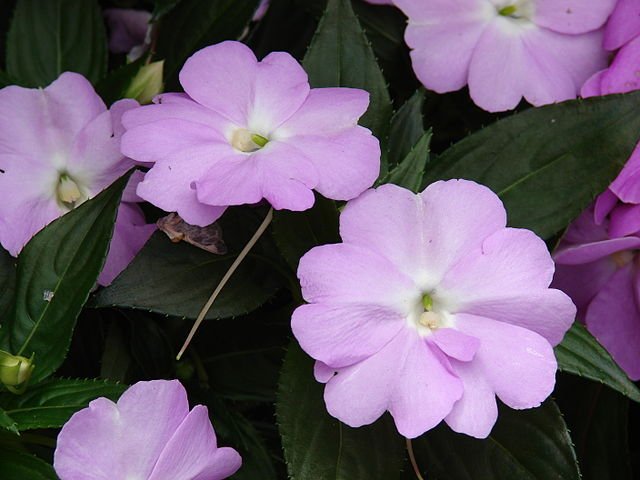 Plants with a great variety of flower and leaf colours are sold in nurseries.[3] The species has been crossed with Impatiens aurantiaca and I. platypetala to improve characteristics such as drought-resistance.[4]
Plants with a great variety of flower and leaf colours are sold in nurseries.[3] The species has been crossed with Impatiens aurantiaca and I. platypetala to improve characteristics such as drought-resistance.[4]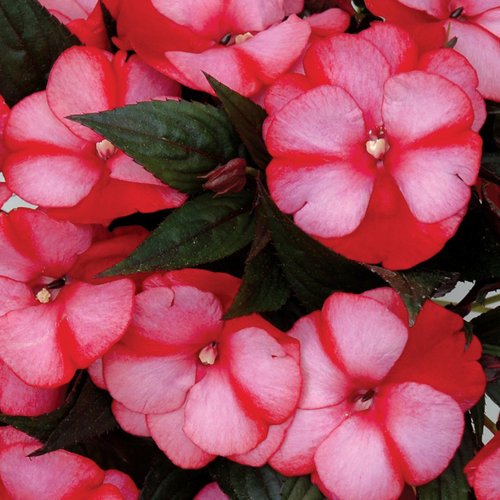 Impatiens hawkeri, the New Guinea impatiens, is a species of flowering plant in the family Balsaminaceae. It is native to Papua New Guinea and the Solomon Islands.[1] It has been bred and hybridized in cultivation to produce a line of garden plants.
Impatiens hawkeri, the New Guinea impatiens, is a species of flowering plant in the family Balsaminaceae. It is native to Papua New Guinea and the Solomon Islands.[1] It has been bred and hybridized in cultivation to produce a line of garden plants.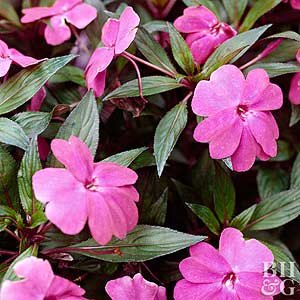 ![70734.jpg]Taxonomy (from Ancient Greek τάξις (taxis), meaning 'arrangement', and -νομία (-nomia), meaning 'method') is the science of defining and naming groups of biological organisms on the basis of shared characteristics. Organisms are grouped together into taxa (singular: taxon) and these groups are given a taxonomic rank; groups of a given r![640px-Starr_070906-8886_Impatiens_hawkeri.jpg]![100168915.jpg.rendition.largest.ss.jpg]
![70734.jpg]Taxonomy (from Ancient Greek τάξις (taxis), meaning 'arrangement', and -νομία (-nomia), meaning 'method') is the science of defining and naming groups of biological organisms on the basis of shared characteristics. Organisms are grouped together into taxa (singular: taxon) and these groups are given a taxonomic rank; groups of a given r![640px-Starr_070906-8886_Impatiens_hawkeri.jpg]![100168915.jpg.rendition.largest.ss.jpg]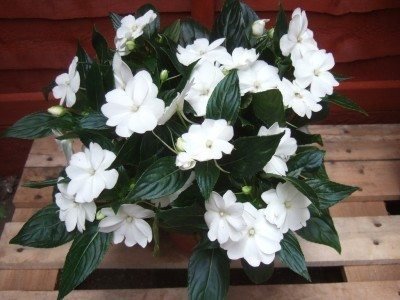 /100168915.jpg.rendition.largest.ss.jpg)ank can be aggregated to form a super-group of higher rank, thus creating a taxonomic hierarchy.(Source)https://en.m.wikipedia.org/wiki/Impatiens_hawkeri
/100168915.jpg.rendition.largest.ss.jpg)ank can be aggregated to form a super-group of higher rank, thus creating a taxonomic hierarchy.(Source)https://en.m.wikipedia.org/wiki/Impatiens_hawkeri
Downvoting a post can decrease pending rewards and make it less visible. Common reasons:
Submit
Premium Impatien: New Guinea

Description
Supersonic Series. These new guineas offer a wide selection of flower colors over bronze foliage. The flower size is larger than on other impatiens. While impatiens do best in the shade, new guineas do need some light to bloom properly. They should avoid the hot, afternoon sun, especially if the soil is dry. New Guineas are pretty forgiving, though, so if they are drooping from too much sun and too little water, give them a drink and they should bounce back. Keep soil moist but not too wet.

Light: Sun to shade
Colors Available:
Dark Salmon
Purple
Red
Downvoting a post can decrease pending rewards and make it less visible. Common reasons:
Submit
Downvoting a post can decrease pending rewards and make it less visible. Common reasons:
Submit
Wow this is great photography and it is really look flowers.so good information
Thanks @ctrl-alt-nwo
Have a great day
Downvoting a post can decrease pending rewards and make it less visible. Common reasons:
Submit
This is very attractive tree with nice flower. I am sorry to say that, this tree is not available in our country. I hope, you will plant this tree at your house.
Downvoting a post can decrease pending rewards and make it less visible. Common reasons:
Submit
They look like your own photos, are they ?
Downvoting a post can decrease pending rewards and make it less visible. Common reasons:
Submit
Impatiens, New Guinea Growing Instructions
Plant New Guinea impatiens in a shady location with rich, well-drained soil. Use a commercial potting mix if you are growing New Guinea impatiens in containers.
Keep the soil slightly moist at all times. New Guinea impatiens don't like sitting in water, but they wilt dramatically if allowed to dry out.
New Guinea impatiens are not intended for human or animal consumption.
source
Downvoting a post can decrease pending rewards and make it less visible. Common reasons:
Submit
Impatiens hawkeri the New Guinea impatiens is a species of flowering plant in the family Balsaminaceae. It is native to Papua New Guinea and the Solomon Islands. It has been bred and hybridized in cultivation to produce a line of garden plants
Source
It was first collected in the Territory of Papua in 1884 and soon became popular as a greenhouse plant. After its discovery, fifteen other similar New Guinea taxa were collected, all of which were later determined to be forms of I. hawkeri.
Plants with a great variety of flower and leaf colours are sold in nurseries. The species has been crossed with Impatiens aurantiaca and I. platypetala to improve characteristics such as drought-resistance
Source
Downvoting a post can decrease pending rewards and make it less visible. Common reasons:
Submit
Nice Pics, but these are Impatiens wallerana, which are slightly different from New Guinea Impatiens (Impatiens hawkeri )
Downvoting a post can decrease pending rewards and make it less visible. Common reasons:
Submit
New Guinea impatiens (Impatiens hawkeri) produce much larger flowers than other impatiens. Prized by home gardeners for the colors of these blooms, which almost glow with vibrancy, New Guinea impatiens are named after their native island of New Guinea. Although their initial introduction to the United States in 1970 didn’t go well, plant breeders have since created new cultivars that have made New Guinea impatiens a common potted and landscape plant in American gardens. The plant grows in U.S. Department of Agriculture plant hardiness zones 10 through 12 and as annuals everywhere.
Sunlight
Place your plant in a location that receives morning sun and afternoon shade. While New Guinea impatiens love sunlight for part of the day, they won’t bloom as well if they receive too much. They require about four to six hours of afternoon shade. Eastern exposures are often ideal.
Water
Water indoor plants when the soil begins to dry. New Guinea impatiens prefer consistently moist soil. However, they cannot tolerate soil that is soggy or too dry. If the soil dries out completely between watering, your plant may wilt or lose flowers. A thorough drench once each week is usually enough for plants grown outdoors. Indoor plants may require more frequent watering.
Warning
Avoid watering overhead to minimize the risk of the plants developing a bacterial or fungal disease, and cut back watering when conditions remain moist or cool.
Feeding
Apply a complete water-soluble fertilizer to potted plants every one to two weeks, or every third watering. Use the lowest recommended rate on the label, and if plants are dry, water thoroughly before fertilizing to avoid burning the roots. Mix a complete slow-release fertilizer into the soil after planting outdoor plants. This is usually sufficient fertilization for New Guinea impatiens grown in landscape beds.
Pruning
Keep your plants vigorous by pinching off old flowers after they finish blooming with your fingers. And clean away all plant material from the soil. New Guinea impatiens shed their flowers naturally, but this can be messy. Pinching and cleaning helps maintain the plant’s appearance and prevents fungal infections and disease. Trim overgrown and leggy plants to keep a compact, bushy shape. When cutting, trim the stems back to a leaf node and supply adequate water and fertilizer to ensure the plant recovers.
source
Downvoting a post can decrease pending rewards and make it less visible. Common reasons:
Submit
Love this post

Shared on twitter dear
Downvoting a post can decrease pending rewards and make it less visible. Common reasons:
Submit
Wows...😱🌺
awesome, awesome, awesome, flowers 🌺 really love your photography 📷, my dear friend ctrl-alt-nwo. love you 😘
Downvoting a post can decrease pending rewards and make it less visible. Common reasons:
Submit
Wow fantastic garden . wonderful flowers and helpful article.
Resteem
Downvoting a post can decrease pending rewards and make it less visible. Common reasons:
Submit
New Guinea impatiens (Impatiens hawkeri) is a fairly new type of impatiens that offers quite a few benefits over the traditional Elfin (Impatiens walleriana ) variety. This good looking breed sports oversized, showy flowers and variegated leaves.
It is able to thrive in many parts of the garden because it tolerates and even prefers partial sun. It is also a vigorous grower that gains more size than the old-fashioned variety and is able to fill in more space with fewer plants.
source
Downvoting a post can decrease pending rewards and make it less visible. Common reasons:
Submit
New Guinea Impatiens liven up shady spots with their bright blooms and contrasting foliage
They are a bit more tolerant of sun than common impatiens
This 6 pack is great for adding bold color to your patio containers or landscape flower beds, decorative mailbox gardens, and when creating borders and lining walkways
Plant in groups of 6 or 9 for full, bold gardens
Plant with other colorful annuals, perennials, or grasses to create texture and interest in your landscape or container
They like rich, well-drained soil; Keep the soil slightly moist to keep the plant happy
If they get a little wilted, they will revive with a drink of water
source
Downvoting a post can decrease pending rewards and make it less visible. Common reasons:
Submit
Nice vibrant color. Which camera are you using may I know? :) Or is it some kind of magic filter?
Posted using Partiko iOS
Downvoting a post can decrease pending rewards and make it less visible. Common reasons:
Submit
Samsung Galaxy. it takes better photos than my camera.
Downvoting a post can decrease pending rewards and make it less visible. Common reasons:
Submit
Yea, looks really sharp. Color is so vibrant.
Downvoting a post can decrease pending rewards and make it less visible. Common reasons:
Submit
The rights to these patented starter plant liners are owned by the breeder. Growers are not allowed to propagate these plants without a contract. While some of these plant varieties are superior in their growth habit and color, they all have royalty fees (already included in our list price) and most require the additional expense of tags.
source
Downvoting a post can decrease pending rewards and make it less visible. Common reasons:
Submit
New Guinea Impatiens are really amazing sir they are very special in nature i am very glad to see many different plants all beacause of you sir you are cheguvera of steemit.
Downvoting a post can decrease pending rewards and make it less visible. Common reasons:
Submit
Plant New Guinea impatiens in nutrient-rich, well-drained soil. New Guineas aren't vigorous, so they won't take up a lot of space in a garden bed. They make great accents and create pops of color when mixed with filling shade plants.
Fortunately, New Guinea impatiens are resistant to downy mildew, which can quickly wipe out other impatiens varieties. Typical garden pests like aphids, thrips, and spider mites are common problems that New Guineas can run into.
source
Downvoting a post can decrease pending rewards and make it less visible. Common reasons:
Submit
Common Name: New Guinea impatiens
Type: Herbaceous perennial
Family: Balsaminaceae
Zone: 10 to 12
Height: 1.50 to 4.00 feet
Spread: 1.50 to 3.00 feet
Bloom Time: Flowers freely
Bloom Description: Wide variety
Sun: Part shade
Water: Medium
Maintenance: Medium
Suggested Use: Annual
Flower: Showy
Leaf: Colorful, Evergreen
source
Downvoting a post can decrease pending rewards and make it less visible. Common reasons:
Submit
Common Name: New Guinea impatiens
Type: Herbaceous perennial
Family: Balsaminaceae
Zone: 10 to 12
Height: 1.50 to 4.00 feet
Spread: 1.50 to 3.00 feet
Bloom Time: Flowers freely
Bloom Description: Wide variety
Sun: Part shade
Water: Medium
Maintenance: Medium
Suggested Use: Annual
Flower: Showy
Leaf: Colorful, Evergreen
source
Downvoting a post can decrease pending rewards and make it less visible. Common reasons:
Submit
That flower has shaded colors

Shared on twitter dear
Downvoting a post can decrease pending rewards and make it less visible. Common reasons:
Submit
Beautiful garden photography and that's a beautiful plants sir. I like it your every photography. I appreciate your valuable Post. thanks for sharing this Australia photography sir.
Downvoting a post can decrease pending rewards and make it less visible. Common reasons:
Submit
Wow wonderful garden.the appreciate your valuable content. excellent photography . so good detail.
100% like and resteem
Downvoting a post can decrease pending rewards and make it less visible. Common reasons:
Submit
Downvoting a post can decrease pending rewards and make it less visible. Common reasons:
Submit
hi!

Strelitzia
This flower looks pretty attractive to me because it is quite different from normal flowers.
It has a common name of the genus is bird of paradise flower / plant, because of a resemblance of its flowers to the bird of paradise. In South Africa it is commonly known as a crane flower and is featured on the reverse of the 50 cent coin. It is the Official Flower of the City of Los Angeles.
source [http://mathiassauer.blogspot.com/2015/02/top-10-most-beautiful-flowers-in-world.html]
Downvoting a post can decrease pending rewards and make it less visible. Common reasons:
Submit
New Guinea impatiens (Impatiens hawkeri) is a fairly new type of impatiens that offers quite a few benefits over the traditional Elfin (Impatiens walleriana ) variety.
Thanks a lot for introducing such wonderful flowers
source
Downvoting a post can decrease pending rewards and make it less visible. Common reasons:
Submit
New Guinea impatiens are generally easy to produce, however, many growers have difficulty getting the plants off to a good start.
Growers have shown us New Guineas that appear normal but have made little or no growth following planting. Very often in these situations, disease, including impatiens necrotic spotted wilt virus, and environmental conditions are not the causes of the poor growth.
However, frequently the level of soluble salts in the potting medium is higher than we would expect so early in the crop.
Fertility Level and Early Growth
Are New Guinea impatiens unusually sensitive to soluble salts level in the first weeks following potting? To find out, we planted cuttings of `Selenia' in 4.5-inch pots of Pro-Mix BX and fertilized the plants with Peter's 20-10-20 Peat-lite Special at 100, 200, 300, and 400 ppm N. A fifth treatment ("delay") consisted of no fertilizer for the first fourteen days after planting, 100 ppm N for the next fourteen days, and 200 ppm N till finish.
Fertilizer treatments were made twice weekly and water was applied between treatments as needed. The experiment was terminated April 10 at 84 days after planting. A similar experiment was conducted between April and June to determine if the response of New Guinea impatiens to fertility rate and soluble salts would differ under higher light and temperature conditions; there was no important difference in plant response between the two experiments so only the earlier experiment is discussed here.
Differences in plant growth between fertilizer treatments were apparent by about six weeks (42 days) after planting. At this time differences between treatments were statistically significant with respect to growth as measured by dry weight. As Figure 1 shows, growth of the young plants was suppressed at the two higher fertilizer rates, 300 and 400 ppm N.
Soluble salts measurements suggest this was due to excessive buildup of soluble salts in the potting medium. Specifically, growth was reduced at soluble salts levels greater than 150 K x 10-5 (1.5 mmho/cm). Some plants receiving the highest fertilizer rates (300 and 400 ppm N) showed a mild yellowing which may have been a symptom of nutrient toxicity.
source
Downvoting a post can decrease pending rewards and make it less visible. Common reasons:
Submit
Beautiful garden photography and that's a beautiful plants @ctrl-alt-nwo sir. I like it your every photography.your every photography is very amazing. I appreciate your valuable content.your content is very interesting sir. I like it your every content. thank you so much sir for sharing this Australia photography.. best of luck your new Post.. thank you.
Downvoting a post can decrease pending rewards and make it less visible. Common reasons:
Submit
maybe this plant. grow in a good climate or temperature.
Downvoting a post can decrease pending rewards and make it less visible. Common reasons:
Submit
Hi @ctrl-alt-now, It is a very good step to keep the environment clean and to make nature beautiful. It is very much like to plant flowers, I like flowering plants too much. I follow you, if you can, help me a little too, thank you Have a Nice Day
Downvoting a post can decrease pending rewards and make it less visible. Common reasons:
Submit
Very nice flowers. Can make any home stylish outside.
Downvoting a post can decrease pending rewards and make it less visible. Common reasons:
Submit
surprisingly but the leaves are almost as beautiful as the flowers themselves :)
Downvoting a post can decrease pending rewards and make it less visible. Common reasons:
Submit
Green is looking dull, pink is siothing
Downvoting a post can decrease pending rewards and make it less visible. Common reasons:
Submit
Amazing plants sir they are so cute thanks for bringing these plants sir,awesome blog post from you.
Downvoting a post can decrease pending rewards and make it less visible. Common reasons:
Submit
From 1999 through 2014, we had been planting close to 30,000 standard impatiens (Impatiens walleriana) in large drifts and throughout many shady locations out in the gardens. The photo directly below shows one of these areas filled with impatiens that were the workhorse of the part shade and shady garden. We had heard of Impatiens Downy Mildew (Plasmopara obducens) adversely affecting impatiens for a couple years prior to this and knew it hadn’t arrived in our area yet (or at least at the gardens). That all changed in 2014 when all of our Impatiens walleriana developed symptoms of this mildew and quickly degraded (see second and third photos below).
source
Downvoting a post can decrease pending rewards and make it less visible. Common reasons:
Submit
Hello my best friend @
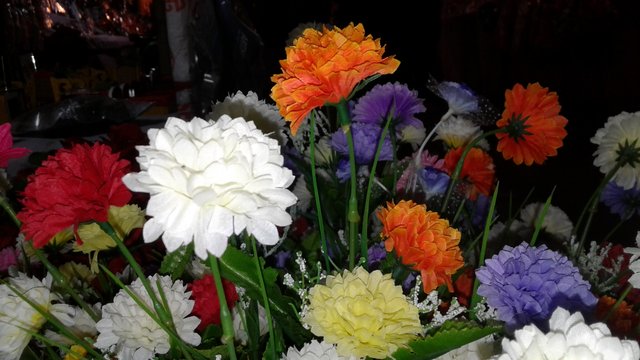
ctrl-alt-nwo How are you?
Very wonderful Australia flower garden photography.
I like it your great full post.
Thanks for sharing your beautiful life
Downvoting a post can decrease pending rewards and make it less visible. Common reasons:
Submit
This is very attractive tree with nice flower. I am sorry to say that, this tree is not available in our country. I hope, you will plant this tree at your house.
Downvoting a post can decrease pending rewards and make it less visible. Common reasons:
Submit